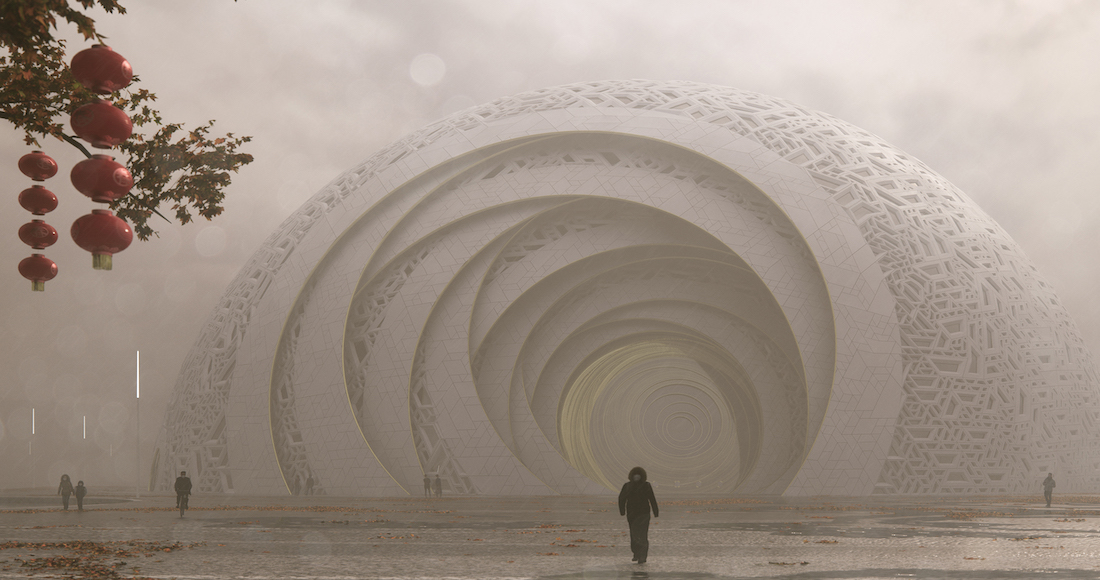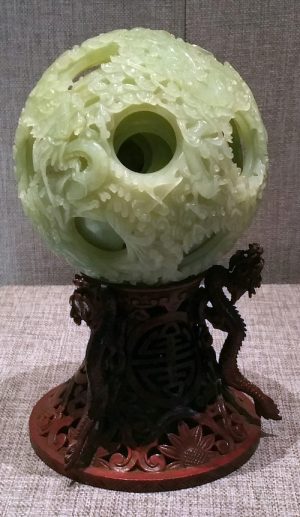Copyright © 2025 Motivate Media Group. All rights reserved.
Enchanted: Puzzeball Theatre
Steven Chilton Architects has created a dramatic proposal for China.

Located in the Huadu District of Guangzhou, China, the Puzzle Ball Theatre proposal by London’s Steven Chilton Architects takes its inspiration from the ancient art of puzzle ball carving. The 2000 seat proposal is designed to house an original and permanent show inspired by the local Yue culture.

Jade Puzzle Ball Guangdong Museum, Guangzhou, China
Chinese puzzle balls are intricately carved sculptural ornaments consisting of several concentric spheres, each freely rotating within the next and traditionally formed from a single block of material. Sculpted by master craftsman, each ball is typically composed of up to 10 concentric layers. Revered for their beauty, mystery and inherent mastery, they are the embodiment of the qualities and characteristics the architecture and show aspire to evoke.
A spherical massing was chosen for the efficiency of its surface area to volume ratio. The primary structure is twin layered dome formed of tubular steel members connected to machined spherical nodes. The cladding panels are formed of GRC and sit as a rainscreen over a substrate formed from insulated aluminium panels with integrated glazing units.
The main entrance is composed of a series of offset spherical surfaces. Each surface has a circular opening that reduce in size concentrically until they reach the glazed portion of the façade. Each spherical surface is offset around its centroid to create an asymmetric overlapping pattern characteristic of puzzle balls.
The surface geometry is inspired by geometric patterns found on wooden window shutters originating from the region. Using generative design techniques, the cladding design was developed with three key goals driving the outcome.
The design started with the mapping of a triangular grid based upon a geodesic polyhedron. The grid was established with input from the engineer to ensure it aligned with the optimal structural solution for the twin layered dome primary steel supporting structure.
Using hierarchical subdivision, a heterogeneous panelization was developed using rhombus and trapezoids as the primary panel shapes. Distributed across the setting out grid over three generations, each one reducing in size from the previous, the density and apparent complexity of the surface increases towards the ground and entrances.
The size of the opening in each panel emerge by the interaction of two main inputs. The first is the need for daylight and views in the theatre lobby and areas adjacent to the main entrances, the second is the desire to keep the façade as closed as possible in the higher parts of the building to avoid heat gain. The outcome pattern is a gentle and gradual variation of solids and void.
The Latest
Textures That Transform
Aura Living’s AW24 collection showcases the elegance of contrast and harmony
Form Meets Function
Laufen prioritises design, functionality and sustainability in its latest collections
Preserving Culture, Inspiring Creativity
Discover the Legacy of a Saudi Art Space: Prince Faisal bin Fahd Arts Hall explores the Hall’s enduring influence on the cultural fabric of Saudi Arabia
Channelling the Dada Spirit
Free-spirited and creative, The Home Hotel in Zurich injects a sense of whimsy into a former paper factory
id Most Wanted- January 2025
Falaj Collection by Aljoud Lootah Design
Things to Covet in January
identity selects warm-toned furniture pieces and objets that align with Pantone’s colour of the year
Shaping the Future of Workspaces by MillerKnoll
Stacy Stewart, Regional Director Middle East & Africa of MillerKnoll discusses the future and evolution of design in workspaces with identity.
Shaping Urban Transformation
Gensler’s Design Forecast Report 2025 identifies the top global design trends that will impact the real estate and built environment this year
Unveiling Attainable Luxury
Kamdar Developments has launched 105 Residences, a new high-end development in Jumeirah Village Circle.
The Muse
Located in the heart of Jumeirah Garden City, formerly known as ‘New Satwa’, The Muse adds to the urban fabric of the area
Cultural Immersion Meets Refined Luxury
The Chedi Hegra opens its doors in AlUla’s UNESCO World Heritage Site
Redefining Coastal Luxury
Sunshine Bay on Al Marjan island combines seaside views, exceptional design, and world-class amenities to create a unique waterfront haven
















